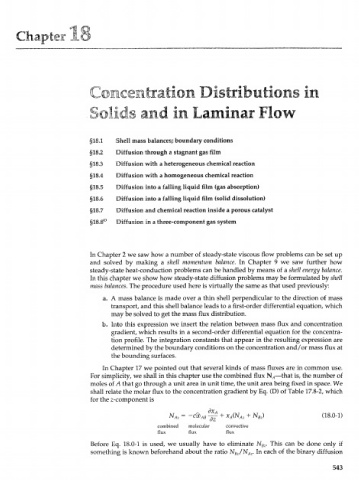Page 563 - Bird R.B. Transport phenomena
P. 563
§18.1 Shell mass balances; boundary conditions
§18.2 Diffusion through a stagnant gas film
§18.3 Diffusion with a heterogeneous chemical reaction
§18.4 Diffusion with a homogeneous chemical reaction
§18.5 Diffusion into a falling liquid film (gas absorption)
§18.6 Diffusion into a falling liquid film (solid dissolution)
§18.7 Diffusion and chemical reaction inside a porous catalyst
§18.8° Diffusion in a three-component gas system
In Chapter 2 we saw how a number of steady-state viscous flow problems can be set up
and solved by making a shell momentum balance. In Chapter 9 we saw further how
steady-state heat-conduction problems can be handled by means of a shell energy balance.
In this chapter we show how steady-state diffusion problems may be formulated by shell
mass balances. The procedure used here is virtually the same as that used previously:
a. A mass balance is made over a thin shell perpendicular to the direction of mass
transport, and this shell balance leads to a first-order differential equation, which
may be solved to get the mass flux distribution.
b. Into this expression we insert the relation between mass flux and concentration
gradient, which results in a second-order differential equation for the concentra-
tion profile. The integration constants that appear in the resulting expression are
determined by the boundary conditions on the concentration and/or mass flux at
the bounding surfaces.
In Chapter 17 we pointed out that several kinds of mass fluxes are in common use.
For simplicity, we shall in this chapter use the combined flux N —that is, the number of
A
moles of Л that go through a unit area in unit time, the unit area being fixed in space. We
shall relate the molar flux to the concentration gradient by Eq. (D) of Table 17.8-2, which
for the z-component is
N Az = -c® AB ^ + x (N Az + N ) (18.0-1)
A
Bz
combined molecular convective
flux flux flux
Before Eq. 18.0-1 is used, we usually have to eliminate N . This can be done only if
Bz
something is known beforehand about the ratio N /N . In each of the binary diffusion
Az
Bz
543

